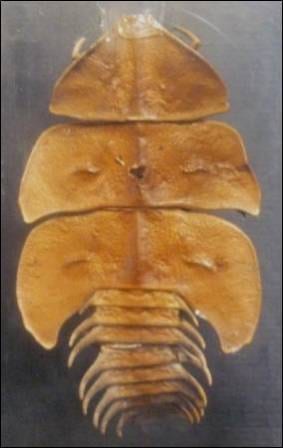Specimen of the Week: Week Seventy-Eight
By Emma-Louise Nicholls, on 8 April 2013
 The specimen that I have for you this week is extremely cool. You could be easily forgiven for thinking this species started life as an illustration in a book on fossils, from where it puffed itself up to being a 3D creature and jumped right off the page. Not related at all to what you’d think it should be, this week’s Specimen of the Week is…
The specimen that I have for you this week is extremely cool. You could be easily forgiven for thinking this species started life as an illustration in a book on fossils, from where it puffed itself up to being a 3D creature and jumped right off the page. Not related at all to what you’d think it should be, this week’s Specimen of the Week is…
**The Duliticola**
1) Is it a trilobite? Is it a woodlouse? Is it the erroneous visual aftermath of a heavy night’s drinking? Nooooooooo, it is in fact a unique species of… rabbit. Ok that’s a lie, it is in fact a type of insect called a duliticola, or ‘trilobite beetle’ to the less scientific-name-use inclined.
2) Our specimen of a trilobite beetle has a body that resembles a dry, cracked leaf. If the leaf happened to be cracked along transverse lines and down a perfect antero-posteriorly directed line of symmetry that is. The pale brown exoskeleton of our specimen reveals it to be a female. Male trilobite beetles are more colourful, with a black or dark brown exoskeleton outlined by a bright orange edging and spots along the central axis. The body is highly segmented, with a tiny head sporting two jointed antennae ahead of two small eyes.
3) The trilobite beetle lives in primary forest in Malaysia and Singapore though if you want to see one, I’d head for Malaysia as although present within a Nature Reserve called Bukit Timah in Singapore, they are comparatively a lot rarer and harder to find there. Having chosen your location for better or worse, you need to look for rotting logs and piles of leaf litter. They don’t like their logs too rotten though so you have to ‘get your eye in’ and be selective with your vegetation.
4) As per any truly enigmatic creature, little is known about the reproductive behaviour of the trilobite beetle, other than after mating, the male errr… dies. The following day, perhaps in a gargantuan effort to overcome her grief… you just don’t know, the female will lay around 200 eggs before a week or so later, succumbing to the over exertion of reproduction herself and also dying. Awwww.
5) Unfortunately for our inquisitive minds, very little research has taken place on the behaviour of trilobite beetles. However, evidence gathered thus far suggests that they most likely rely on the use of chemical communication in the same way that moths and ants do, essentially meaning that they are all about taste and smell.
Emma-Louise Nicholls is the Museum Assistant at the Grant Museum of Zoology
 Close
Close




